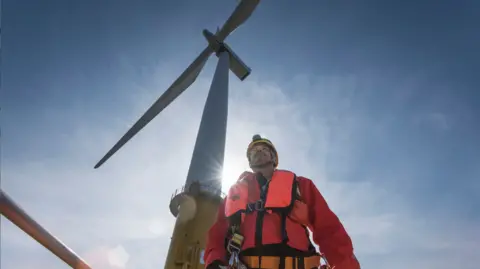Business
Nine offshore wind farm projects awarded in UK auction
 Getty Images
Getty ImagesA total of nine offshore wind farm contracts have been awarded by the government after last year’s auction failed to attract any bidders at all.
The contracts are part of a wider slate of green energy projects that also include tidal and solar power, and will provide enough electricity to fuel the equivalent of 11 million UK homes, the government said.
However, while the new offshore wind projects have been broadly welcomed, some experts questioned whether they would generate enough capacity to meet renewable energy targets set for 2030.
Households are also facing higher energy bills later this year, with a typical bill to rise by 10%.
On Tuesday, a total of 131 contracts have been awarded to firms for projects which will generate 9.6 gigawatts (GWs) of renewable energy.
The new offshore projects include what will be Europe’s largest and second-largest wind farms, Hornsea 3 and Hornsea 4, which will be built off the Yorkshire coast.
The contracts are boost to the UK’s renewable energy sector, after no companies bid in the auction to build offshore wind farms last September.
Back then, the industry said the guarantee price offered by the then Conservative government for electricity generated by the wind farms did not take into account higher costs such as construction materials, which had risen because of inflation.
Keith Anderson, chief executive of Scottish Power, which was awarded two offshore wind farm contracts in the auction, said offshore wind was “back on track after last year’s misstep”.
“It will allow investment into manufacturing in the UK. It allows the sector to get back up and running and it puts the government back on track for hitting targets, really important targets to decarbonise the sector,” he told the BBC’s Today programme.
‘Ambitious targets’
The Labour government is aiming to produce 60GW of energy through offshore wind farms by 2030.
The offshore wind farm projects announced on Tuesday provide capacity of 4.9GW.
Pranav Menon, a research associate at Aurora Energy Research, said the government still has some way to go to meet its goal.
“It still falls short of the pace required to meet its ambitious targets,” he said.
Mr Menon next year’s auction would be “the last chance” to procure enough capacity for delivery before 2030, with an additional 31GW needed to meet the target 60GW target for offshore wind.
Campaign group Greenpeace warned that “the government clearly needs to take a hard look at how this system is working”.
Ami McCarthy, Greenpeace UK’s political campaigner, said: “5GW of offshore wind is of course welcome, but it is only about half of what is required each year to meet the government’s 2030 target.
“The last renewables contract auction was a catastrophic failure, and in fact the biggest disaster for clean energy in almost a decade – because of this, the new government has an uphill battle.”
Labour’s Energy Secretary Ed Miliband said the new government had “inherited a broken energy policy”, but claimed “these results show that together, this government and the energy industry are securing investment into our country”.
He hailed Tuesday’s auction as a “significant step forward” in the government’s aim of achieving “energy independence and lower bills for good”.
Gas and electricity prices rose in 2021 as the global economy began to re-open from lockdowns implemented in the Covid pandemic. The increase accelerated the following year following the invasion of Ukraine by Russia, which is a major oil and gas producer.
While the long-term aim is to bring energy prices down and lessen the UK’s reliance on overseas providers, it will take some time for consumers to benefit.
Household bills are expected to rise after the energy regulator Ofgem lifted the cap on the price paid for each unit of gas and electricity used in 27 million homes in England, Wales and Scotland.
From October, a typical household’s annual energy bill will rise by £149. People using an average amount of gas and electricity will pay £1,717 a year.








